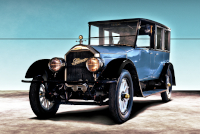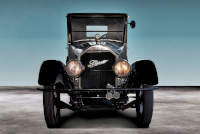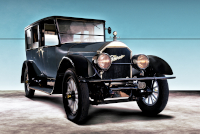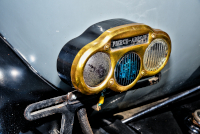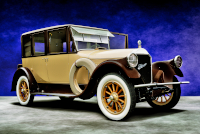Location:
RM Sotheby's, Hershey, 2023
Owner: Conrad Fletcher | Golden, Colorado
Prologue:
I've enjoyed checking through the history of #336048 and the legend of Babe Ruth. I apologize for not snapping at least one photo of the Yankee pinstripe upholstery, but in retrospect find that focusing on the tail light is rather fortuitous. There might be a "Usual Suspects" scenario at play. But in any case, I tried to make this unrestored limousine look its best without corrupting all of the patina. There may not be much remarkable about the car itself, except for decades of story-telling that has (despite whatever the truth may be) created a cult of celebrity that is genuine in its own regard. In this case, I feel very fortunate to have taken a glance. And I appreciate the irony, that the two Model 33 cars we've seen lay spurious claims to famous owners. Babe Ruth in this case, and Milton S. Hershey in the case of #332157. But as they say, every car tells a story, and this seems to be a good one.
- - - - - - - - - -
► Image Source: Nikon D750 (24.3 MP)
References:
- Ralston, Marc. "Pierce-Arrow" A.S. Barnes & Co., Inc., San Diego, CA. 1980, page 118-119, 231
- RM Sotheby's: The auction listing for #336048 from the 2023 Hershey auction.
- Pierce-Arrow Society: Source of the forum exchange that sheds light on the Babe Ruth legend.
The Enclosed-Drive Limousine is a new body style for the Model 33. Pierce-Arrow now manufacture the coachwork using a more traditional aluminum sheet over ash frame, relinquishing the cast aluminum process after so many years. The 4-speed gearbox also bows out, replaced with a 3-speed unit. Otherwise, the mechanicals take much from the dual-valve six chassis of years past, fitted to a more modern platform, albeit less extravagant in material and production.
The Babe Ruth Legend Pierce-Arrow Limousine
Back in 2010, some chatter on the Pierce-Arrow Society forum described the circumstance of the Babe Ruth legend, that this Model 33 had been ordered by or for the New York Yankees star. In this case, it's best to rely on the words of its then-owner and those who knew the people involved in car's transactions.
Owners prior to Mr. Fletcher write, "Les Ostrander of Jamestown, NY owned it for about 35 years, from 1970 to 2004. Loren Holland of Ilion, NY owned it before Les... Here is the challenge: Les Ostrander always said he found the Pierce on a truck bound for a museum in Pennsylvania. When he learned it originally belonged to Babe Ruth, he talked Loren into selling it to him. He publicized the Babe Ruth connection for as long as he had the car. I have pictures of induction week at Cooperstown, pictures with Babe’s daughters and grandchildren in the car, letters from [the Baseball Hall of Fame] discussing purchasing the car from Les, all kinds of support from western NY Babe Ruth League baseball people. What I don’t find is any documentation officially linking Babe Ruth to the car. I cannot imagine the Hall of Fame would want to purchase it without verifying Babe Ruth owned it, but whenever I asked Les for 'proof' that it belonged to Babe Ruth he would answer, 'Let them prove it didn’t.'"
A reply a few days later answered, "Loren put an ad in 'Cars & Parts' sometime in the mid 70s, wanting to sell this car. I was in Rhode Island heading home and decided to stop and see it. At the time, Loren had it stored in a roadside museum not far from Ilion, NY. He took me there to look over the car. As we talked, he mentioned a 1936 Town Car that he also wanted to part with. I bought the Town Car! Later, while at work, a fellow car nut, Ray Lipka, mentioned he wanted 'an older Pierce' to tinker with. I told him about your car and the next weekend we were off to Ilion. He bought it, tinkered with it, loaded it onto his trailer, and headed to a car show. That’s when Les spotted the car, took the bait, and was hooked. I’m pretty sure Ray was the one who started the baseball connection to the car—he had played in the minors and for a short time majors. Les tried, for years, to get the connection between this car and the Babe made, but never could."
To pause for a moment, Babe Ruth preferred to drive himself, sometimes eschewing the team bus to travel from game to game. And in these early days, he seemed to prefer roadsters and touring cars. So a chauffer-driven limousine feels out of character, and too formal.
Accoutrement that perpetuates the story (myth?) include pinstripe upholstery that is "supposedly" the same as the 1921 Yankees uniform. Somewhat, I would say—perhaps darker, though perhaps the hue is a trick of age. Without doubt the upholstery looks like what we want to believe a 1921 Yankees uniform looks like. The upholstery lines the entire passenger compartment, not just the seats. The compartment also includes a vent for cigar smoke and a liquor cabinet with some un-named bottle of old-age bourbon still residing. Another cue, that tail light, I will discuss in the aesthetics section, which is where our "Usual Suspects" hypothesis enters stage.
Of course, these interior features perpetuated an unresolved mystery, however common they might be in their own right. And it is the mystery that kept the car in unrestored condition, as any possibility of truth in the legend prohibited past owners from perhaps erasing that history. But at this point, the legend is the history just as much as the myth might never have been.
Motor: 6,796 cc (marketed as 415 cubic inches, actual 414.7) Dual-Valve inline 6-cylinder | 101.6 mm x 139.7 mm (4" x 5½")
single cast "en bloc" with removable head
Valvetrain: T-head, 4 valves per cylinder, twin-plug ignition via Delco dual distributor with two plugs per cylinder
The two banks of spark plugs can be operated independently or in unison via dashboard switch control. Early Model 33 cars built through 1924 use two distributors, whereas later Model 33 cars use a single, large dual-distributor.
Aspiration: single Stromberg carburetor
The Model 32 first used the Stromberg unit, which replaced Pierce-Arrow's own design.
Power: 100 hp @ 3,000 rpm
Output would at least equal the Model 31 at 72 hp, but with a speed increase from 2,600 rpm to 3,000 rpm the actual figure approaches 100 hp.
Drivetrain: 3-speed manual transmission, rear-wheel drive
The 4-speed gearbox retired with the Model 31, as did right-hand drive.
Architecture: steel frame, aluminum sheet body panels over white ash frame
Wheelbase: 3,505.2 mm (138 inches)
Etymology:
Though of a different generation, the Model 33 and Model 32 succeeded the Model 31, crossing over the transition from cast-aluminum bodies to aluminum sheet coachwork. These are the only Pierce-Arrow cars of the early 1920s until the addition of the lesser Model 80 in 1925. The Model 33 spans late 1921 to 1925, at which point the Model 33 will be updated by the rather obsolete Model 36.
The model's origin involves a redevelopment of the Model 38, which Pierce-Arrow re-generated as a new 3-series beginning at number 31. The company had used the '30' designation twice before with the 30N of 1907 and later 30U of 1909. So beginning a new, four-valve-per-cylinder series with the bare '31' numerical designation makes some sense. The Model 31 carried over to the Model 32, sharing the basic dual-valve motor, but in a very different platform.
The enclosed-drive limousine style no longer abandons the driver to the elements. He would be a chauffeur, a hired hand, and often sat in an open cockpit in a limousine or sedan de ville (town car) configuration. A partition with a large glass window fronts the passenger compartment. A brass horn attached to the frame behind the driver's left ear allows the passenger to communicate, (i.e., give commands), visible in our main image.
Figures:
In the first Model 33 production run from 1922 to 1924, Pierce-Arrow built 6,580 examples. Ralston supposes fewer than 50 Model 33 cars survive.
Value:
Chassis #336048 sold for $20,900 at RM Sotheby's 2023 Hershey auction.
Babe Blue: Visual Elements Tempt Legend, but Are Rudimentary
Tempting to uphold the Yankee legend, but the limousine's passenger appointments are not necessarily bespoke. The smoking vent and liquor cabinet might be found in sedans, for instance. The grey pinstripe upholstery is more compelling. Pierce-Arrow loved their textiles and used imported fabrics of luxury material and high thread count. Chassis #336048 uses pinstripe upholstery throughout the cabin—across the three-cushion sofa, on both jump seats, and all around the walls and head lining.
Surfaces exposed to sun have yellowed, whereas hidden surfaces such as the stowed jump seat offer the best indication of how the fabric originally looked. (I defer to RM's images for evidence, given the environment and glare at Hershey on a brilliant October afternoon.) Outside, the pale blue paint is a bit more Babe the Blue Ox, but a pretty choice for an upper-class coach. Note the brass talking horn placed by the driver's left ear, shown in the main image, the means of passengers directing the driver.
New York: Likely Original Destination Feeds Speculation
Pierce-Arrow probably delivered chassis #336048 to a New York address, judging by the barrel headlamps. Many refer to this headlamp configuration as "New York lights," though we should remember that the barrel lights remained standard despite the overwhelming popularity of the integrated Dawley headlamp design.
Modern Box: Simplified Styling of the 1920s
Beginning with 1920's Model 32 development, the new decade replaces the curves of the golden years with an altogether straight body across all configurations. The change is a sharp departure for the brand, but both on-trend and necessary. These bodies use 14-gauge aluminum over white ash frames, replacing the intricate steel frame and cast-aluminum bodies Pierce-Arrow pioneered in the brass era. The change is as much a concession to cost as changing attitudes in style.
Another Usual Suspect: Perhaps Overlooked Genesis of the Babe Ruth Yarn
A much more modest indicator might have spurred the Babe Ruth legend. The Yankee American Auto Lamp Co. produced marker lights and tail light assemblies for American cars throughout the pre-War and post-War periods. This Model 33 uses a bracket-mounted triple tail light fixture that clearly reads "Yankee" across the top. One wonders if the tail light is the seed of the Babe Ruth connection, and the story a Usual Suspects scenario in which Verbal Kint merely uses the visual cues in agent Dave Kujan's office to spin a tale about legendary figure, Keyser Soze.
In the film, only when it is too late do we see Kujan's eyes cross the words, "Quartet — Skokie, Illinois," on the bulletin board's manufacturer plate, then the words "Kobayashi Porcelain" on a smashed piece of coffee mug. Here, the word "Yankee" on the tail light housing is entirely conventional, as are all the meaningless references in the film. Yankee will make tail light assemblies for Pierce-Arrow through the classic era. But perhaps the word sparked a more elaborate idea, and a bit of mischief.
Last Updated: Mar 26, 2025

